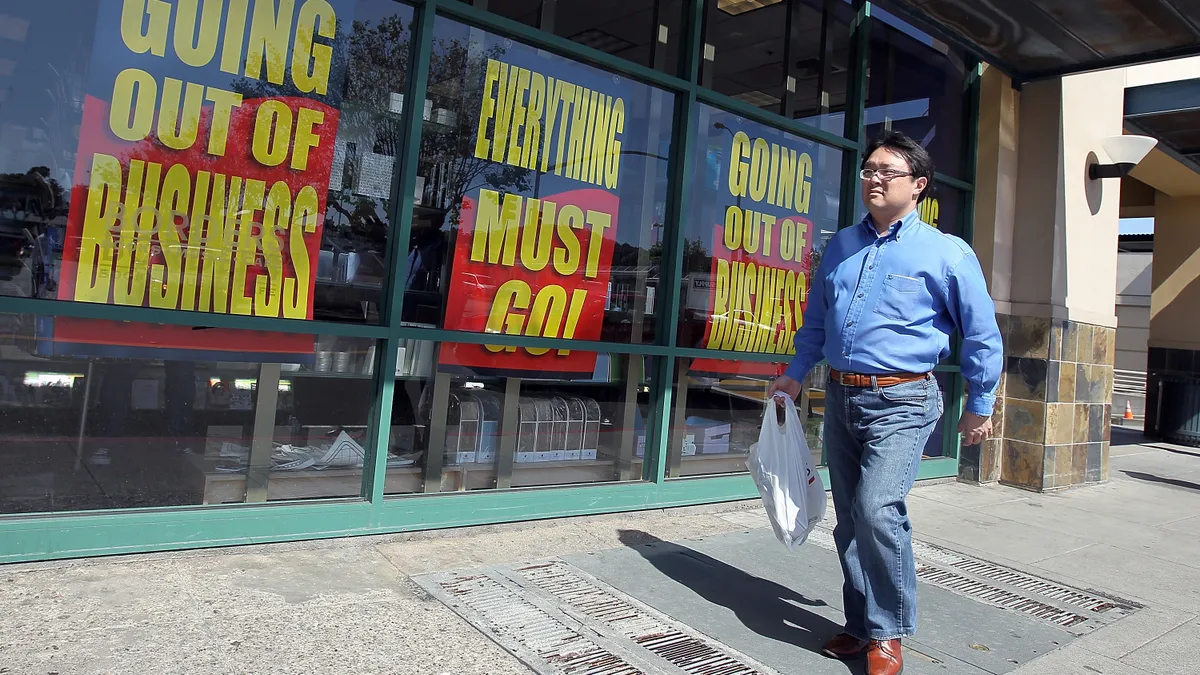Dive Brief:
- As major retailers attempt turnarounds in Chapter 11 bankruptcy this year, they're working against historical probability. In a recent report, consulting firm AlixPartners said it found that only 16% of retail bankruptcies over the past decade ended with a turnaround, while 38% ended in a sale of the company and 46% ended in liquidation.
- That liquidation rate for bankrupt retailers is much higher than the 10% of bankruptcies in non-retail industries that end in liquidation, according to the authors of the AlixPartners report. Working against the industry is the short timeline for rejecting leases — a consequence of a 2005 revision to the U.S. Bankruptcy Code.
- At 19 Chapter 11 filings for the year so far, the number of retail bankruptcies in 2017 is just one behind 2008, when the industry was slammed by the Great Recession's credit crunch and consumer pullback. According to AlixPartners, "there's significant possibility that we will surpass" the 2008 record, especially given soft sales across many categories this year. Moreover, "with many retailers moving into the most capital-intensive period of the year, filings may even accelerate," the authors write.
Dive Insight:
The findings from AlixPartners — which has a well-known retail turnaround team that has worked on several retail restructurings, including that of Gymboree and BCBG Max Azria — echo those of other bankruptcy analysts. History, many analysts have found, has not been the friend of retail bankruptcies.
And retailers know it. That's likely why we've seen filings this year that were carefully crafted and negotiated ahead of time. As Joshua Friedman, a legal analyst with Debtwire wrote this summer, "[T]he recent retail restructuring landscape is littered with pre-arranged reorganizations, sales and liquidations," due mainly to "the difficulty retailers face in achieving successful restructurings the longer they sit in Chapter 11."
Gymboree, Payless, rue21 and others have gone into bankruptcy with plans that more or less looked like the final results. (As it happens, Gymboree, Payless and rue 21 have all exited bankruptcy in recent weeks.)
One notable exception from the year is Toys R Us, which did manage to wrangle an agreement on a $3 billion bankruptcy loan ahead of filing, but otherwise seemed unplanned, as the retailer faced a sudden liquidity crunch as wary suppliers tightened terms and scaled back shipments.
Retailers looking to increase their chances of a successful turnaround can buy themselves time by pulling back on their capital spending and other expenses, and they should have a firm grasp on their liquidity position, debt covenants and other potential bankruptcy triggers, the AlixPartners authors wrote in their report. Retailers should also be realistic about their sales prospects and develop a feasible plan, have a detailed understanding of capital markets and do deep analysis on their stores' profitability, according to the firm.
The authors suggest retailers can even negotiate leases against the backdrop of a potential Chapter 11 filing, "both to achieve rent savings and to inform store closure decisions with an understanding of likely go-forward lease expenses." The report authors found that 21% of bankrupt retailers closed more than half of their store footprint, while 32% closed between a fourth and half of their stores. Only 21% closed no stores in bankruptcy.















